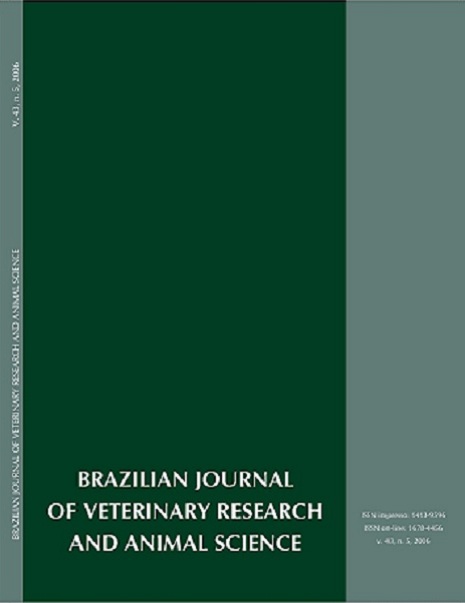Influence of sea sources of carotenoids added to the diet of laying hens on the egg yolk pigmentation
DOI:
https://doi.org/10.11606/issn.1678-4456.bjvras.2006.26575Keywords:
Egg yolk, Pigmentation, Laying hens, Carotenoids, Marine sourcesAbstract
This experiment was carried out to evaluate the effect of the utilization of two sources of marine carotenoids added to the diet on the egg yolk pigmentation of laying hens. A completely randomized design using 288 laying hens with 32 weeks of age assigned in 12 treatments, with 3 repetitions of 8 layers each was used. The hens were fed a corn soybean basal diet supplemented with 0.80%; 1.20%; 1.60%; 2.00%; 2.40% salmon oil (Salmo salar) or 0.50%; 0.75%; 1.00%; 1.25%; 1.50%; and 1.75 % of marine algae (Schizochytrium sp). The diets were isocaloric and isoproteic. The yolk values of ²-carotene equivalents (µg/g egg yolk) for the laying hens fed salmon oil diet ranged significantly (P<0.05) from 27.04 µg/g to 45.96 µg/g, respectively, for 0.80% and 2.40% salmon oil. Laying hens fed marine algae showed ²-carotene equivalent means ranging from 33.04 µg/g to 72.66 µg /g egg yolk, respectively, for 0.50% and 1.75% of marine algae diets. Visual score for the egg yolk pigmentation at the eighth week of experiment showed significance (P<0.05) among means ranging from 4.75 to 8.17 for 0.80% and 2.40% salmon oil diets, respectively. The yolk pigmentation measured by visual score (colorimetric fan) of eggs from hens fed diets enriched with marine algae ranged from 5.92 (0.50% algae) to 11.58 (1.75% algae). Haugh units were significantly (P<0.05) improved when marine algae was added to the basal diet. The significant (P<0.05) correlation and determination coefficients observed between the percentages of salmon oil or marine algae in the diet and the ²-carotene equivalents found into the yolk (µg/g) showed a strong positive linearity between these variables.Downloads
Download data is not yet available.
Downloads
Published
2006-10-01
Issue
Section
UNDEFINIED
License
The journal content is authorized under the Creative Commons BY-NC-SA license (summary of the license: https://
How to Cite
1.
Carvalho PR de, Pita MCG, Piber-Neto E, Mirandola RMS, Mendonça-Júnior CX de. Influence of sea sources of carotenoids added to the diet of laying hens on the egg yolk pigmentation. Braz. J. Vet. Res. Anim. Sci. [Internet]. 2006 Oct. 1 [cited 2024 Apr. 24];43(5):654-63. Available from: https://revistas.usp.br/bjvras/article/view/26575





